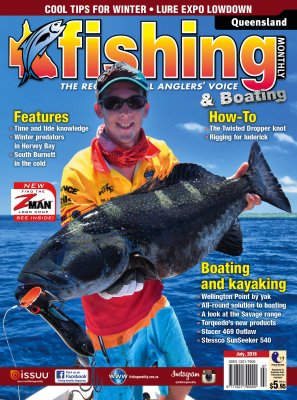Best fishing times and tides: weighing it all up by Sean Thompson
 When is the best time to go fishing? If you are a regular angler you've probably been asked this a thousand times. Or maybe you've asked this of others. So what is the answer? Is there such a thing?
When is the best time to go fishing? If you are a regular angler you've probably been asked this a thousand times. Or maybe you've asked this of others. So what is the answer? Is there such a thing?
Some anglers believe the answer to this question is just a case of buying an Angler's Almanac or checking the Maori tide charts and going fishing at the best predicted times. But what if it's rained for two weeks solid, or its blowing a gale, or there are 40 boats sitting on your secret spot? Can you seriously expect to catch fish then just because a chart tells you that you can?
The answer is no; it's not that easy. Anglers should not expect cut-and-dried predictability when they go fishing. That's not to say fishing results are just random, and that tides, times and moons don't matter - they do. It is just that other factors are at play. To maximise your chance of fishing success you need to weigh up a whole range of information, and then be able to adapt your plans if all doesn't go to plan.
Let's take a look at some of the key factors at play to maximise, rather than guarantee, your chances of fishing success.
PLANNING AHEAD
Very often I see or hear casual anglers going fishing on the spur of the moment, or when they can fit a trip in between weekend chores. In today's busy society, finding the time to go fishing can be challenging at times - but this is all the more reason to make the most of it when you do go.
With a bit of planning, casual and seasoned anglers can go well armed with information and not simply turn up and hope for the best. Whether you a planning a two-hour session or a week long fishing trip, you should go prepared by looking at tide charts, moon phases, weather forecasts and fishing reports, and have a specific plan to target one or more species. Let's have a look at each of these factors in more detail.
Targeting fish in season
Having a basic fishing plan should start with finding out the best seasons to target specific fish species in your local or chosen area. In Southeast Queensland, for example, there's not much point in targeting tailor off the beach in summer when you'd be much better off chasing summer whiting. Likewise, if you want to catch a mangrove jack, there is little point targeting them on a cool winter's day when you would be better off targeting schooling bream or luderick in your local estuary.
Apart from reading magazines such as this, there is also a wealth of books that will help you understand your local fishing seasons and the best places to target fish locally. Look for those that have some localised maps and information such as the River to Reef series (by Bill Johnston); the Gregory 's Fishing Guide; Australian Fishing Network area guides and some of the older books such as Fish Australia: An Essential Fishing Companion and Fishing Monthly Magazines' South East Queensland and Queensland Fishing Annuals from the late 1990s early 2000s if you can get your hands on them from a library or ebay. Of course there is also a wealth of information on the internet in websites, Facebook pages and forums.
All anglers should also keep a fishing diary to look for regular patterns in your own fishing. If you record a range of information on species caught, time, moon, tide, weather, baits and lures, after a while a pattern will emerge. As I've spoken about in this magazine before, the best way to do this is either in an electronic fishing diary such as an Excel spreadsheet or in a commercially available product such as Ken Fox's Fishing Log. The Fishing Log can be downloaded in a format that burns onto a CD. It lets you record all the useful fishing information, plus you get the benefits of seeing your GPS spots displayed on point-and-click maps. It also has animated graphics for how to tie knots, tide information and more. Ken can be contacted on (08) 8298 4527.
MOONS AND TIDES
Tides
Once you know the various seasons to target your favourite fish, the next thing to consider is the tides. Which are the best tides for fishing? There is no definitive answer, but there are some rules of thumb you can apply for particular species.
For example, species such as flathead and barramundi are ambush predators, and use the falling tides or lack of water to sit and wait for baitfish to retreat from shallow water. The predators position themselves at the edge of sandbank drop-offs, weed-beds, drains, gutters, small creeks and bankside snags for baitfish to return to deeper water as the tide drops. Likewise, they will wait for the first hour of the tide for the survivors to head back up to the shallows before spreading out.